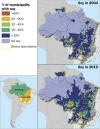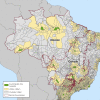Agricultural intensification and childhood cancer in Brazil
- PMID: 37903255
- PMCID: PMC10636353
- DOI: 10.1073/pnas.2306003120
Agricultural intensification and childhood cancer in Brazil
Abstract
Over the last several decades, Brazil has become both the world's leading soy producer and the world's leading consumer of hazardous pesticides. Despite identified links between pesticide exposure and carcinogenesis, there has been little population-level research on the effects of pesticide intensification on broader human health in Brazil. We estimate the relationship between expanded soy production-and related community exposure to pesticides-on childhood cancer incidence using 15 y of data on disease mortality. We find a statistically significant increase in pediatric leukemia following expanded local soy production, but timely access to treatment mitigates this relationship. We show that pesticide exposure likely occurs via water supply penetration. Our findings represent only the tip of the iceberg for substantial health externalities of high-input crop production and land use change. Our results are of particular interest in developing contexts with demand for intensified food production systems and underscore the need for stronger regulation of pesticides and increased public health attention to exposure in the broader community.
Keywords: agriculture; cancer; pesticides; public health.
Conflict of interest statement
H.K.G. has an ongoing consulting relationship with the nonprofit National Wildlife Federation. The National Wildlife Federation did not provide editorial oversight over the contents of this manuscript.
Figures
References
-
- Cohn A. S., et al. , Cattle ranching intensification in Brazil can reduce global greenhouse gas emissions by sparing land from deforestation. Proc. Natl. Acad. Sci. U.S.A. 111, (2014), http://arxiv.org/abs/1408.1149. - PMC - PubMed
-
- B. Phalan et al., How can higher-yield farming help to spare nature? Science 351, 450–451 (2016). http://arxiv.org/abs/1011.1669. - PubMed
-
- Garnett T., et al. , Sustainable intensification in agriculture: Premises and policies. Science 341, 33–34 (2013). - PubMed
-
- Recena M. C. P., Caldas E. D., Pires D. X., Pontes E. R. J., Pesticides exposure in Culturama, Brazil-Knowledge, attitudes, and practices. Environ. Res. 102, 230–236 (2006). - PubMed
Publication types
MeSH terms
Substances
LinkOut - more resources
Full Text Sources
Medical



